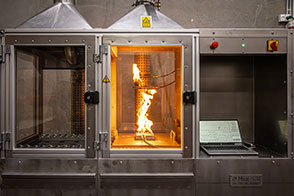Published: 30.10.25
Which classification does your product need? How can you develop your product quickly and cost-effectively? What specifications does the fire laboratory need before your fire test? See DBI’s new free guide, and get useful tips on how to complete your fire test and project in the most efficient way.
A classified fire test is the gateway to the market for your product. Passing the test provides documentation of your product’s fire performance, which you can present to authorities, consultants, and contractors when your product is used in a construction project.
But how do you move most effectively from product development to fire testing, certification, and market access? DBI has created a short, easy-to-understand guide that you can download for free.
There are many factors to consider when selecting a test laboratory and preparing for a fire test.
“The very first step is to determine which classification you need for your product or construction project, and you must also clarify the intended field of application for testing,” says Christian B. Andersen, Head of DBI’s Fire Testing Department.
“In addition, there are several practical matters to address – such as collecting relevant product specifications, building the test specimen, drying time after installation, etc.”, he says.
It’s not just about finding a test laboratory that can perform the fire test – it’s also about partnering with an organization that can assist throughout the entire process, from product development to testing.
“At DBI, we’ve developed a number of tools that can give early indications of a product’s fire performance during the development phase. For example, we conduct small-scale indicative tests that make it possible to test different construction variants and adjust the product as many times as needed before investing in a full-scale test,” says Christian B. Andersen, adding:
“Computer-simulated fire tests can also be used to provide insight into a product’s fire properties. Both methods can help reduce costs and shorten time-to-market.”
Once you’re ready to test, you should work with the test laboratory to determine the appropriate scope of the test specimen and choose the test facility best suited for the field of application and classification you are targeting.
“For example, if you’re testing a façade system, it might be worth considering testing according to the expected upcoming European façade test standard, which will likely require larger test specimens. This way, your test results are better future-proofed,” says Christian B. Andersen, and continues:
“As a manufacturer, you should align expectations with the test laboratory early on about which product variants and classifications your customers are requesting. This allows the laboratory to ensure that the testing process and final documentation match those needs as efficiently and cost-effectively as possible. At DBI, we also aim to deliver the final test report within 30 days after the fire test, because we know that ‘time-to-market’ is a crucial factor for manufacturers,” he says.
Contact

Christian B. Andersen
Head of Fire Testing
Marine, Materials and Constructions
